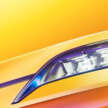It might not look like it but this is the new, third-generation Porsche Panamera, which employs the marque’s signature evolutionary design. The second-generation luxury sedan was still good looking at the end of its seven-year life-cycle, so it’s no bad thing that this new one ‘retains the characteristic lines and proportions of the model line’.
The proportions are derived from length of 5,052 mm (the longer Executive version is 5,202 mm long), width of 1,937 mm and height of 1,423 mm (Executive 1,428 mm). That’s just three mm longer than the outgoing car, with identical width and height. Retained indeed.
Put new and old side-by-side and you’ll notice that up front, there’s an additional air intake above the number plate, which compensates for the increased air requirement of the drive systems. The redesigned window line on the profile reinforces the sedan character of the four-door coupe, while the outer edges of the rear window are flush with the contour of the body.
Porsche wants to shape its ‘Turbo’ name into a brand of its own and the push starts with the new Panamera. Turbo variants are characterised by a distinctive rear apron with painted diffuser panels and a unique front apron in body colour. There are also chrome-plated tailpipes in dark bronze and optional centre-lock wheels, which can also be specified on the other models.
The Turbo-exclusive colour Turbonite is used as a contrast on the side window strips and the Turbo logo on the tailgate, as well as in the Porsche crest on the bonnet, wheels and steering wheel. Inside, Turbonite is combined with carbon elements to create a sporting ambience. It can be found, for example, in the central rev-counter and as the colour of the centre console controls.
Porsche revealed the new Panamera’s interior earlier this month, and it’s a good-looking cockpit that the carmaker says ‘features the ideal balance between digital and analogue control elements’ in addition to putting the elements essential for driving along the driver’s axis.
The big news is an optional 10.9-inch passenger display shows vehicle performance data on request, allows operation of the infotainment, and supports video streaming while the car is in motion. In order to avoid distracting the driver, this passenger display cannot be seen from the driver’s seat.
There will be a total of four E-Hybrid powertrains for the new Panamera, in response to high demand, Porsche says. The Panamera Turbo E-Hybrid will be available from market launch. At the heart is a ‘fundamentally revised’ 4.0-litre V8 turbo engine that combines with a new 190 PS electric motor for combined output of 680 PS and 930 Nm. That’s good for 0-100 km/h in just 3.2 seconds and a top speed of 315 km/h.
The e-motor has been integrated into the housing of the ‘comprehensively redesigned’ eight-speed PDK dual-clutch gearbox. Dispensing with a separate e-motor housing saves around five kg. The integration of the unit into the oil circuit of the transmission also optimises the heat balance of the electric drive unit and allows higher continuous output from the motor, Zuffenhausen says.
The hybrid’s 25.9 kWh battery provides pure electric range of up to 91 km in the combined WLTP cycle, or 83–93 km in the city cycle. A new 11 kW onboard AC charger shortens the charging time to 2 hours and 39 minutes.
If the Turbo E-Hybrid’s big power is not required, the Panamera and Panamera 4 variants will also be available at launch. Modifications to boost pressure, fuel injection flow rate and ignition timing optimise the performance of the 2.9-litre V6 turbo engine, which now generates 353 PS and 500 Nm of torque – an increase of 23 PS/50 Nm. This improves the Panamera’s century sprint time to 5.1 seconds (was 5.4s) and top speed to 272 km/h (was 270 km/h).
The new Panamera comes with dual-chamber two-valve air suspension with Porsche Active Suspension Management (PASM) as standard. The two-valve bit separates the rebound and compression stages of the damper control and therefore offers a wider range between comfort and sportiness.
Porsche says that the system noticeably dampens impacts from transverse joints and road damage while at the same time ensuring more body stability in dynamic driving situations. The car’s handling can be further improved thanks to optional all-wheel steering.
Porsche Active Ride active suspension is available as an option for the E-Hybrid models. This system ‘surpasses other suspension concepts in all relevant parameters and offers an unprecedented range between driving comfort and driving dynamics’.
The basis for this is newly developed active shock absorbers – also with two-valve technology – each connected to an electrically operated hydraulic pump. This generates a volume flow in the damper according to demand and can therefore build up forces between the body and wheels in a ‘lightning-fast, highly precise and targeted manner’. A weight-saving single-chamber air-suspension system complements this tech.
Porsche says that in dynamic driving situations, the active suspension can overcompensate for pitching and rolling tendencies to reduce the acceleration forces acting on the occupants. The new Panamera ‘leans into the corners like a motorcycle would’, pulling the front down when accelerating and the rear when decelerating.
We move on to the tech section. To log in with their personal Porsche ID, all customers need to do is scan a QR code displayed in the PCM with their phone. Apple CarPlay and Android Auto enable the linking of smartphone and vehicle data for improved usability, but there’s more for iOS users.
The integration of vehicle functions from the MyPorsche app into Apple CarPlay enables optimised operation of digital functions and creates a clearer overview. Functions such as air con, seat massage and ambient lighting can be controlled directly via CarPlay or with the Siri voice assistant.
The Panamera comes standard Matrix LED headlights. The HD Matrix LED lighting system, which has more than 32,000 pixels per headlight, is available as an option. It offers completely new lighting features, such as dedicated lane brightening. The illumination range is up to 600 metres.
The assistance systems have been upgraded too. The standard active speed assistant now interacts with traffic signs, and if the system is active, the Panamera will not automatically drive faster than the appropriate speed limit. Porsche InnoDrive including adaptive cruise control features active lane guidance and junction assist. A swerve assistant is now also part of the suite. During auto parking, the driver no longer has to be in the car thanks to the new Remote ParkAssist function.
Made in Leipzig, Germany, the Panamera is priced from 107,800 euros (RM552,501) in its home country, while the Turbo E-Hybrid starts from 192,500 euros (RM986,609). Deliveries in Europe will begin in March 2024.
The post 2024 Porsche Panamera – third-gen gets more power, tech; Turbo E-Hybrid w 680 PS, 930 Nm, 91 km e-range appeared first on Paul Tan’s Automotive News.




